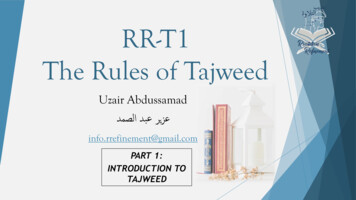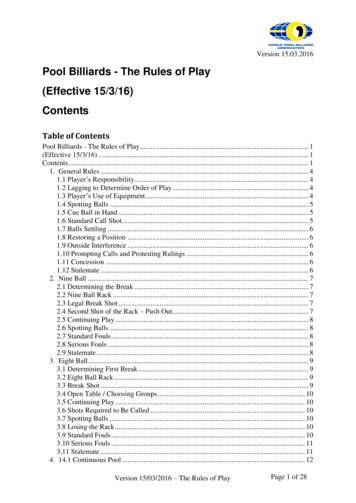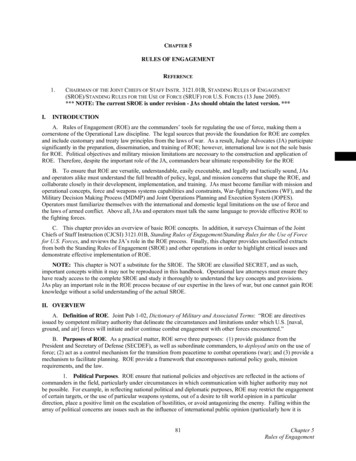
Transcription
RR-T1The Rules of TajweedUzair Abdussamad عزير عبد الصمد info.rrefinement@gmail.comPART 1:INTRODUCTION TOTAJWEED
What is Tajweed? جتويد جيد Linguistic definition: “To better” or “To improve” Technical definition: To recite the Qur’an by giving every letter its due rightthrough pronouncing it from its respective articulation point and observing itsprecise characteristic. Alternative definition: To observe the correct rules of recitation, so we reciteaccording to the recitation of the Prophet ﷺ The smallest science in Shari’ah, but one of the most important!
WHY IS TAJWEED IMPORTANT?“Recite it with its true recital”Allah says:“Those to whom we have given the Book recite it with its true recital, they arethe ones who believe in it.” (2:121) The Rulings of Tajweed have all come from the Prophet ﷺ himself in apractical manner as a result of the instruction of Angel Jibril عليه السالم . The practical manner of reciting the Qur’an was then taught from theProphet ﷺ to the companions and was thereafter passed on to the followinggeneration via chains of oral transmission.
Why is Tajweed important?Allah says:Abdullah ibn Amr ibn al-Aas رضي هللا عنه stated that the Prophet ﷺ said, “Tothe person with the Qur’an, it is said,“Recite and ascend! Recite measuredly justas you used to recite in the world! Yourrank will be at the last verse you recite.”(Abu Dawud, Tirmidhi, Nasai)“. And recite the Qur’an withmeasured recitation (73:4)In Imam al-Jazari’s Tayyibat-an-Nashr, hementions the statement of the great companionAli ibn Abi Talib رضي هللا عنه who says:“Tarteel means to read/pronounce the letterswith Tajweed and having knowledge of where topause.”We will focus onthe theorybehind recitingthe Qur’an withTarteel
Why is Tajweed Important?Imam al-Jazari in his famous poem Muqaddimah al-Jazariyyah says: وا ألخذ ابلتجويد حمت الزم من مل يصحح القرآن آمث ألنه به االإهل أآنزال وهكذا منه إالينا وصال And applying the rules of Tajweed is an issue of absolutenecessityWhoever doesn’t read the Qur’an correctly is a sinner,Because with it, Allah has revealed the Qur’an,and it is in this way it has reached us.”
Why is Tajweed Important?Sheikh Saalih al-Usaymee says in his poem“A Description of the Stages in Attaining the Qur’an”: وال متل عن هنجهم فتبتدع فرس كام سار الصحاب واتبع “Do as the companions did and follow,And waiver not from their path, becoming an innovator.” Reciting the Qur’an incorrectly (deliberately) and choosing todelve into other sciences of Shari’ah without learning the firstscience (Tajweed) is not the way of the companions and scholars!
Excellence of Tajweed The smallest science in Shari’ah, but one of the most honourable! It is related to the Speech of Your Creator, Allah! Allows you to perfect an act of worship! Learning how to recite the Qur’an correctly is you trying to fulfil thefirst Sunnah of the many Sunan acts. This is the Prophetic way! The path of taking the Qur’an and itsrecitation first.
Rulings with Tajweed There are 2 aspects to considerPractical Application of Tajweed,in other words, reciting theQur’an with Tajweed.Fardh al-AynTheory of Tajweed, in otherwords, having knowledge of therulings with regards to Tajweed.Fardh al-KifayahAt the time of revelation, the Arabs were already speaking with high levels ofeloquence, so the recitation of Qur’an was learnt by oral transmission. Overtime, asIslam spread far and wide, the rules of Tajweed and Qira’ah became codified in orderfor people to understand and apply into their recitation. But the most important partof Tajweed is practical application!
An Analogy of Tajweed:Taken from Ustadh Jamal Correct Recitation of the Qur’an and Pronunciation of the letters are likethe vessel for the meaning of the verses you recite (its content). The meaning of the verses you recite will take the shape of yourrecitation just the way the liquid takes the shape of its vessel! How is it befitting to reflect over verses you have incorrectly recited?
Reciters to Listen to:The 3 Reciters that Impacted me Even though I have not met them, these 3 reciters who mastered Qira’ah intheir lives, significantly impacted my life!Sh. Mahmoud Khalil alHusary رحمه هللا Sh. Muhammad Siddiq alMinshawi رحمه هللا Sh. Muhammad Ayyub رحمه هللا
Listening to the Correct Recitation Listening is a vital part of developing your Tajweed, this is how thecompanions learnt! The Qur’an has not been sent down for entertainment, Do you listen to the recitations solely for the melody/voice of a reciter? Rather you should listen to reciters with immaculate Tajweed before theirbeautiful voice! This would then allow you to ponder over the verses properly! The Prophet ﷺ has said: “Among the people who recite the Qur’an with themost beautiful voice is the man who, when you hear him, you think that hefears Allah ﷻ .” (Ibn Majah)
Major & Minor Mistakes حلن جيل & حلن خفي Major mistakes: Clear and Obvious mistakes Regardless of whether they change the meaning or not. Considered to be Haram (forbidden) by consensus of the scholars. Minor mistakes: Unclear and Hidden mistakes. Don’t change the meaning. General Muslim who has not studied Tajweed may not be aware of these Considered to be Makruh (disliked) by consensus of the scholars.
MAJOR & MINOR MISTAKES حلن جيل & حلن خفي Major MistakesMinor MistakesChanging a letter into another(pronunciation)Not observing the characteristics ofletters correctlyChanging a vowel into another vowelNot observing the Rulings of TajweedExtending the length of a vowel AND notextending a stretched vowel (madd)Stopping/beginning in incorrect placeswithin the verses Problematicmeaning
The Harakat (vowels) & stretching 3 vowels in the Arabic Language: Fathah, Kasrah, Dhammah. They vowels should be short and sharp in length, to allow fluent recitation. Each vowel may be stretched by the Huruf al-Madd: اب يب ب يو اوي ب ب ب
JoiningSukun & Shaddah A letter with Sukun must be read without any vowel sounds. You must hold onto the sound/pronunciation of the respective letter. The vowel of the preceding letter must attach/join onto the letter withSukun. A Shaddah on a letter means that the letter will be ‘doubled’ The sound of the letter is ‘pulled’ due to the internal Sukun and then thesound is released by the respective vowel on the letter. The vowel of the preceding letter must attach/join onto the letter withShaddah.
Some Etiquettes Isti’adhah is to seek refuge from Shaytan. The scholars say it is Mustahabb (recommended) to say this before reciting. Others say it is Wajib (obligatory) Thus, it is best to say it when you are first beginning your recitation. Scholars say it is necessary to say before beginning any Surah (except Surah Tawbah) Permissible to say before starting anywhere else in the Qur’an.
The Different Scripts Most common scripts of the Qur’an today are the Madinah Script & SouthAsian Script. Read from the script you are most comfortable and familiar with!(Taken from Safar Publications)
RR-T1The Rules of TajweedUzair Abdussamad عزير عبد الصمد info.rrefinement@gmail.comPART 2:MAKHARIJ ALHURUF
Some Motivation Never feel down about where you are with your abilities in reciting! Even if it’s from scratch, start now! The Qur’an shouldn’t be treated as asubject! In every aspect, the Qur’an is a personal journey! Have patience and persevere! For 10 years during the Makkan Period, the Prophet ﷺ was rejected andhumiliated despite him having these same words revealed to him! The one who learns one verse of Qur’an, ponders over it and acts upon it isbetter than the one who has learnt the entire Qur’an but does not act upon it! Shaytan will target you a lot more when you are on your journey with theQur’an! Don’t let Shaytan bring you down.“We have not sent down to you the Qur'an that you be distressed”(20:2)
Makharij al-Huruf : ريض هللا عنه From the definition of Ali ibn Abi Talib خمارج احلروف ) 1 صفات احلروف ) 2 جتويد احلروف) 1 معرفة الوقوف ) 2
Makharij al-Huruf The Articulation Points of Letters. Where the letters originate from. The Great Imam al-Jazari says in his Muqaddimah al-Jazariyyah: قبل الرشوع أآوال أآن يعلموا ليلفظوا بأأفصح اللغات اإذ واجب علهيم حممت خمارج احلروف والصفات “It is without doubt compulsory for the reciter,to know before starting (recitation):The articulation points and characteristics of letterSo that they can articulate in the most eloquent of languages.”
Makharij al-Huruf There are 17 articulation points over 5 organs of speech.-There are 5 organs of speech:1)Al-Jawf: The empty space in the chest and mouth.2)Al-Halq: The throat.3)Al-Lisaan: The tongue.4)Ash-Shafataan: The lips.5)Al-Khayshum: The nasal cavity.
Al-Jawf: اجلوف The Oral Cavity The 3 letters of Madd come from the empty space in the chest and mouth. So any time the vowels are stretched, the sound given off should originate fromthe oral cavity So there is only 1 Articulation Point within the Oral Cavity, as it is empty space!In the state ofMadd, they arefrom Al-Jawf! اوي Huruf al-Madd
Al-Halq: احللق The Throat 6 letters 3 Articulation PointsArticulation PointsBottom of the throat أآقىص احللق Middle of the throat وسط احللق Top of the throat أآدىن احللق Letters ءه عح غخ
Alif & Hamza: The Difference Alif is a consonant and is used to STRETCH the Fatha of its precedingletter It never has a Harakah Nor does it ever appear at the beginning of words, rather it dependson the preceding letter Hamzah is a letter that is defined with a Harakah! Physically appears in different forms: الكتاب ء ؤ ئ أآ إا ااا
Al-Lisan: اللسان The Tongue 18 Letters 10 Articulation PointsArticulation PointDeepest part of the TongueBack of the TongueMiddle of the TongueSides of the TongueFront sides of the TongueLetters ق ك جشي ض ل
Al-LisanThe Tongue 18 Letters 10 Articulation PointsArticulation PointTip of the Tongue with the gumsabove the upper front 2 teethTop of the Tip of the tongue withthe gums above the upper front 2teethTip of the Tongue with the roots ofthe upper front 2 teethTip of the Tongue with the edge ofthe upper front 2 teethTip of the Tongue slightly touchesthe inner part of the bottom 2teethLetters ن ر تدط ثذظ سصز
Ash-ShafatanThe Lips 4 letters 2 Articulation PointsArticulation PointBottom lip (with theupper front 2 teeth)Both lipsLetters ف بمو
Al-KhayshumThe Nasal Cavity No letters! The Quality of Ghunnah originates from here! Accompanying quality of ن and م 1 Articulation Point غنة
Isolation Method Rather than saying the letter itself, it is moreeffective to ISOLATE THE SOUND of a letter Put a Sukun on the desired letter you want topractice, and precede it with a Hamzah with all thevowels E.g. for the letter ع َآ يع ا يع ُآ يع ِ
RR-T1The Rules of TajweedUzair Abdussamad عزير عبد الصمد info.rrefinement@gmail.comPART 3:SIFAT AL-HURUF
Sifat al-HurufLinguistic definition: It is the plural of Sifah, which means attribute/characteristicsTechnical definition: The way of describing the letter when it occurs at itsarticulation point, which differentiates it from others (other letters)From the definition of Ali ibn Abi Talib ريض هللا عنه :1) جتويد احلروف 2) معرفة الوقوف 1) خمارج احلروف 2) صفات احلروف
Analogy of Makharij & SifatClothing Type of clothing: E.g. Thobes This is like Makhārij Description of that clothing: Long-sleeve, collared, white thobe This is Sifāt For example, the bottom of the throat: They share the same articulation but they differ in their qualities ءه ءه All of these are thobes, but they differ intheir colour, material, design etc.These are bottom of the throat letters,but they differ in their qualities
Sifat al-Huruf Allows you to perfect your pronunciation of the letters by giving them its due right Gives you an insight to the nature of each letter Allows distinction of letters that share the same Makhraj. Without application of Sifāt, the letter would sound incorrect or even like another letter. The observation of Sifāt is one of the main components to an excellent recitation. There are 2 types of Sifāt. صفات الالزمة صفات العارضة Permanent CharacteristicsTemporary Characteristics ليس لها ضد لها ضد
Sifat al-Lazimah with Opposites لها ضد : صفات الالزمة There are 5 Sifaat with opposites. These Sifaat are important to know as they are accompanying qualities of theletter when pronounced. My tip: don’t overwhelm yourself with memorising and remembering the lettersfor each Sifaat Main thing is to ensure you can apply them properly Use it as a tool to perfect your pronunciation The 5 categories: Breath Sound of the letter Elevation/lowering of the back of thetongue Closure/openness of the mouth Quickness in pronunciation
Sifat al-Lazimah with oppositesthe breathAl-Jahr اجلهر Blocking the breath from runningupon articulationRemaining lettersLow level of HamsAl-Hams اهلمس Allowing the breath to run uponarticulation فحثهشخصسكت فحث َّه ي ْ ش ٌص سك ي
Sifat al-Lazimah with OppositesThe Sound of the LetterAsh-ShiddahAt-Tawassut الشدة التوسط Imprisoning the soundof the letter uponarticulationPartiallyimprisoning/running thesound of the letter uponarticulationRunning the soundof the letter uponarticulation لنعمر Remaining letters ءجدقطبك ت ْ َآج يد قطٍ بك ي ل ين ُع ير Ar-Rikhawah الرخاوة
Sifat al-Lazimah with OppositesThe Back of the TongueAl-Isti’laa’ ا إالس تعالء Al-Istifaal ا إالس تفال Elevation of the back of the tonguetowards the roof of the mouth whenpronouncing a letter.Lowering the back of tonguewhen pronouncing the letter. خصضغطقظ Remaining Letters خ َّص ض يغطٍ قظ حروف التفخمي
Sifat al-Lazimah with OppositesClosure/opennessAl-ItbāqAl-Infitāh اإلطباق اإلنفتاح Elevation of the middle and sides ofthe tongue so that the sound istrapped at the roof of the mouth dueto closure of the mouth. صضطظ Lowering of the middle and sides of thetongue so that there is space between itand the roof of the mouth. The sound ofthe letter is released due to openness.Remaining letters
Sifat al-Lazimah with oppositesQuickness of PronunciationAl-IdhlāqAl-Ismāt االإذالق االإصامت Letters that are quick/fluent inpronunciation due to the ease ofarticulation at the tip of the tongueand at the lips .Letters that are not quick inpronunciationRemaining letters فرمنلب ف َّر م ين لب
Sifat al-Lazimah w/OUT opposites صفات الالزمة اليت ليس لها ضد Ghunnah – غنة : The sound that comes from the nose when pronouncing ن م Safeer – صفري : The accompanying whistling sound that accompanies thearticulation of س ص ز Takreer - تكرير : This is a characteristic that MUST BE AVOIDED. It accompaniesthe articulation of ر and is the trilling/rolling sound of the tongue. Tafashshee – تفيش : This is the spreading of air and sound when pronouncing ش Istitalah – ا إالس تطاةل : Known as elongation. This is a characteristic exclusive to thepronunciation of ض in the state of Sukun. It involves pushing the tongueforward from the back to the front. ْ ْو when they are preceded with aLeen – اللني : The ease in articulating ي letter carrying a Fathah.
Analysis of some lettersBottom of the throat ءه
Analysis of some lettersTip of the tongue تدط
Homework! Analyse the differences between the letters of the top of the throat. Analyse the differences between the letters of the tip of the tongue with theedge of the upper front 2 teeth. Analyse the differences between the Safeer letters. Name all the characteristics of the letter ض
RR-T1The Rules of TajweedUzair Abdussamad عزير عبد الصمد info.rrefinement@gmail.comPART 4:Introductory Rule
Qalqala Linguistic definition: Unrest Technical definition: To echo the sound of a letter when it has a Sukun (Sakinah letter) The main purpose of a Sukun is to hold/isolate the sound of the letter. However,Qalqala slightly disobeys this. The letters of Qalqala are: قطبجد ي يدع يوا ييعل ق يطب ج ٍد ح يب ٌل أآ يطعمه يم ا يقر ْآ
Importance of Qalqala Notice how all the letters of Qalqala are letters of Shiddah.Ash-Shiddah الشدة Notice the ending of each Ayah with and without Qalqala!Imprisoning the soundof the letter uponarticulation ءجدقطبك ت If we were to pronounce theletters of Qalqala without theecho, the sound of the letterwould not be heard!So Qalqala allows the sound theseletters to be heard in the state ofSukun!
The levels of Qalqala The distinction of the echo can vary depending on where the Qalqala occurs!LowestWhen the Qalqala occurs in the middle of a word/ayah ح يب ٌل HighestWhen you stop on a Qalqala letter that becomes atemporary Sukun. Also, when you stop on a temporarysukun and Qalqalah occurs before. واليف يجر وت َّب أآح ٌد
Demonstration
RR-T1The Rules of TajweedUzair Abdussamad عزير عبد الصمد info.rrefinement@gmail.comPART 5:Tafkheem & Tarqeeq
Tafkheem & Its Letters Linguistic Definition: To make thick Technical Definition: To pronounce a letter with heaviness such that you have afull mouth of resonance. Tafkheem is a fruit of Al-Isti’lā’ The mouth sounds like it is full when raising the back of the tongue. التفخيم / حروف المفخمة In all cases, these letters will sound heavy. خصضغطقظ خ َّص ض يغطٍ قظ
The Levels of Tafkheem Despite always being read with Tafkheem, the reciter must consider thedifferent conditions these letter may be in. As a consequence, the level of heaviness can vary depending on what theTafkheem letter carries.HighestWhen the Tafkheem letter has a Fatha with Alif قال َ َ خل َWhen the Tafkheem letter has a Fatha alone ق When the Tafkheem letter has a Dhammah/Stretched Dhammah ُق ْولُ ْوا ْWhen the Tafkheem letter has a Sukun اق َر ْأ َ قِ ْي When the Tafkheem letter has a Kasrah/Stretched Kasrah ل Lowest
Letters subject to both Tafkheem orTarqeeq Letters can be categorised according to Tafkheem or Tarqeeq.Letters that will always possess the quality ofTafkheem2) Letters that are subject to both Tafkheem orTarqeeq3) Letters that will always possess the quality ofTarqeeq1)
Alif: Tafkheem or Tarqeeq? Alif is a letter used to stretch the Fathah of the preceding letter Hence why we say Alif at best is a weak letter, since it depends on the preceding letter! Therefore, if it precedes a Tafkheem letter with Fathah, it will be read with Tafkheem. The stretched vowel has a sound that is heavy/full. الضَّ أل يني However, if the preceding letter is a letter of Tarqeeq, then the Alif will in turn be read withTarqeeq. كن
Letters Subject to both Tafkheem orTarqeeq Lām of the name of Allah هللا Imam al-Jazari says in his Muqaddimah al-Jazariyyah: عبد هللا : عن فتح أآو مض ك وخفم الالم من امس هللا “Make Tafkheem of the Laam of the name of Allah,(if it is preceded) by a Fathah or Dhammah as in: ”عبد هللا
Lam of the Name of Allah If the letter before the Lam of the name of Allah carries a Fathah or Dhammah, the letterLam will be pronounced with Tafkheem. ف يضل هللا من هللا If the letter before the Lam of the name of Allah carries a Kasrah, the letter Lam will bepronounced with Tarqeeq ب يسم هللا
The Letter Ra, ر Letters that are subject to Tafkheem & Tarqeeq The letter Ra is a letter that can be read with both Tafkheem or Tarqeeq. But this depends on conditions Like any other letter, Ra can come in 2 states: Ra Mutaharrikah: When it carries a Harakah. Ra Sakinah: When it carries a Sukun ير ررر
Ra Mutaharrikah راء متحركة When the letter Ra, ر carries a Fathah or Dhammah it should be read withTafkheem. Pay attention to making these types of Ra, ر distinct to other letters that maybe Tarqeeq. ربما رب يُك أآ يدراك When the letter Ra, ر carries a Kasrah it should be read with Tarqeeq. ريي ٌح رب ُّي يون
Ra Sakinah راء ساكنة The General Principle: If the letter preceding Ra Sakinah carries a Fatha or aDhamma then the Ra Sakinah will be pronounced with Tafkheem. If the letterpreceding Ra Sakinah carries a Kasrah then the Ra Sakinah will be pronouncedwith Tarqeeq. ف يرع يون اليق يرآن ا يرسل If you stop (do waqf) on the letter Ra, and it becomes a temporary Sukun,then it will follow this rule, ONLY WHEN STOPPING. اليهاُك التَّكثر ي يوم ت يبَل ال َّرسآئر
Ra Sakinah راء ساكنة What if the preceding letter is also a Sakinah letter? This usually occurs when the Ra becomes a temporary Sukun upon stopping. We must look at the letter preceding the Sakinah letter, as the sound of the vowel followsthrough to the temporary Ra Sakinah. واليف يجر ص يف ٌر ي س ٌر
Exceptions to the Principle ofRa Sakinah1.ْ then the Ra Sakinah willWhen the letter preceding Ra Sakinah is a Ya Sakinah, ي be pronounced with Tarqeeq.-Regardless of whether the letter before it has a Fatha/Dhamma or not!-The middle of the tongue is raised when we pronounce the letter ي and the backof the tongue is lowered, hence Tarqeeq is done more easily upon pronunciation ofthe Ra Sakinah. خ ي ٌري بص ي ٌري
Exceptions to the Principle ofRa Sakinah2. When the letter following Ra Sakinah is a Tafkheem Letter, then the Ra Sakinahwill be pronounced with Tafkheem.-Regardless of whether the letter before it has a Kasrah!-This allows ease in pronunciation. ق يرطا ٍس م يرصادا ف يرق ٍة
What about the word(Ash-Shu’ara:63) ? ف ير ٍق Imam al-Jazari says in his Muqaddimah al-Jazariyyah: لكرس يوجد , فرق : واخللف يف “There are different allowed ways (Tafkheem & Tarqeeqof )راء due to the Kasrah (on the ”)ق Lowest Level of Tafkheem! The most well-known transmission of the Riwayah of Hafs ‘an ‘Asim is the way of Shatibiyyah Hence, reciting via the way of Shatibiyyah allows Tafkheem or Tarqeeq of this Ra Sakinah. The other well-known route of Hafs ‘an ‘Asim is the way of Tayyibah. Some of the transmissions mentioned in Tayyibah an-Nashr mentions only Tarqeeq and othersmention only Tafkheem. But the Asl is what is mentioned above.
Exceptions to the Principle ofRa Sakinah3. When the letter preceding Ra Sakinah is in a separate word, separated byHamzatul Wasl, then the Ra Sakinah will be pronounced with Tafkheem.-Regardless of whether the letter before it has a Kasrah!-This is the case even when starting on Hamzatul Wasl.َ لمن يارت اليم يطمئنَّة ا يرجع يي
Hamzatul Wasl مهزة الوصل Known as the connecting Hamzah It is silent when you are connecting 2 words Not defined with a Harakah. It is only pronounced when STARTING on it (we will discuss how we pronounce itlater on) Consequently, the South-Asian scripts of the Qur’an define it with a Harakahwhen it occurs at the start of an Ayah. A Hamzatul Wasl is signified with the head of the letter ص in the Madinah Script. س يبحان هللا
Hamzatul Qat’ مهزة القطع Literally defined as the ‘Cutting Hamzah’ It is always pronounced, whether it occurs in the middle of an Ayah orwhether you are beginning on it. It is defined with a Harakah. ا ََّّيك ِ إا َّن ا يذ ِ
Surah Fatiha: Madinah Script
Surah Fatiha: South-Asian Script
Some problems with theSouth-Asian script They sometimes define Hamzatul Wasl with a Harakah for the beginning on it.
RR-T1The Rules of TajweedUzair Abdussamad عزير عبد الصمد info.rrefinement@gmail.comPART 6:Similar Letters
Similar letters When reciting the verses of the Qur’an, letters that are similar can come adjacent toeachother. We must consider the rulings that occur when a letter has a Sukun and the followingletter which is similar has a Harakah. In all cases, we must do Idghaam إدغام which is to merge the letters There are 3 types of letters to consider in terms of their similarity:- Mutamaathilayn مامتثلني : 2 of the SAME letters متجانسني : 2 letters that are from the same Makhraj but differ in Sifat- Mutaqaaribayn متقاربني : 2 letters that have close Makhaarij but similar Sifat- Mutajaanisayn
Idgham al-Mutamathilayn إادغام املامتثلني The 2 letters are the same. First letter is Sukun. Second letter has a Harakah. They are merged together completely and become one strengthened letter (Mushaddad). رِب يْ جتارُت يم ت اب ا يذه يب بكت ي ب وق يد دخل يوا َّد
Idgham al-Mutajanisayn إادغام املتجانسني The 2 letters are similar, as they have the SAME MAKHRAJ. First letter is Sukun. Second letter has a Harakah. They are merged together completely ) (كامل and become one strengthened letter(Mushaddad). يليه يثج َّذل وقال يْ َّطأئف ٌة يارك يب َّمعنا إا يذ َّظلموا ق يد ت َّب َّني َّذ ط َّم َّظ َّت
Idgham al-Mutajanisayn إادغام املتجانسني The Idghaam in these cases are mainly complete كامل However, there are some places in which the Idghaam al-Mutajaanisayn isincomplete.ْ comes before ت This is when the letter ط Thus, we enter with the ط and exit with the following ت ُّْ أآح يط َّْ بس يط يط يط ت ت : إادغام املتجانسني انقص
Idgham al-Mutaqaribayn إادغام املتقاربني The 2 letters are nearby in Makhraj They have some similar Sifat First letter is Sukun. Second letter has a Harakah. They are merged together completely and become one strengthened letter (Mushaddad). يَنل يق ُُّك وق يل َّرب ك ر
RR-T1The Rules of TajweedUzair Abdussamad عزير عبد الصمد info.rrefinement@gmail.comPART 7:Lam Sakinah in thedefinite article يال
Lam Sakinah(Definite Articles) الم الساكنة In the Arabic Language, words starting with ال are known as definite articles. ْ is subject to 2 rules, depending on the following letter.Hence, the ل يال الم الشمس ية Preceding any of thefollowing letters: طثصرتضذدنسظزشل االإدغام : MergePreceding any of thefollowing letters: ابغ جحك وخف عقميه االإظهار : Make clear الم القمرية
Demonstration of examples اليغن اليف يرد يوس اليحك يمي اليخب يري اليم يسجد ا إالنيسان ا َّلط َّيبات َّالر يْحن التَّأئب يون الصالح يني َّ َّالزب يور ادلُّ نييا
RR-T1The Rules of TajweedUzair Abdussamad عزير عبد الصمد info.rrefinement@gmail.comPART 8:The Rules ofMeem Sakinah
The Rules of Meem Saakinah أآحكم املمي الساكنة There are different rules to consider when ْم occurs. These rules are dependent on the letter that follows ْم يم االإظهار الشفوي االإدغام الشفوي IdghamShafawi االإخفاء الشفوي Ikhfa’ ShafawiIdharShafawi
Idgham Shafawi االإدغام الشفوي االإدغام means to join. Idghaam, Idghaam Shafawi : If after a Meem SaakinahSaakinah, ْم ْم there is another Meem, م , the Meemwill be merged and Ghunnah should be done.Meem Saakinah is merged, Ghunnah is done م خلق يُك م ين قل يوِ يم َّمر ٌض ْم ول يُك َّماكس يت يمت له يم َّما يشأء يون
Ikhfa’ Shafawi االإخفاء الشفوي Ikhfaa’, اإخفاء means to hide or to conceal. Ikhfaa’ Shafawi: To make the lips touch without pressure and to do Ghunnah whenpronouncing ْم If after a Meem Saakinah ْم there is the letter Ba, ب , Ikhfaa’ Shafawi will be donewith Ghunnah. To completely seal the lips or to allow them to firmly touch is a mistake, whichshould be avoided. ب ينتُ يم بما كن يوا Lips touch lightly, Ghunna is done ي يعتص يم اب هلل ْم ي يوم يه ابرز يون
Lips closed, or a small gap? Over the years, there has been many discussions with regards to how Ikhfaa’ Shafawi shouldbe done. Should the lips be closed, or should there be a small gap? This is a matter of a difference of opinion The most accepted opinion, which is the opinion given by Sheikh Ayman Suwayd, and SheikhAl-Ma’sarawy is that the lips should be closed! Sheikh Ayman Suwayd actually retracted the opinion of there being a gap between the lips The Rightful Recital, “Attention Teachers of Qur’an Part 5: A Real-Life Case: Open orClosed Lips?”
Idhaar shafawi االإظهار الشفوي االإظهار means to make clear or to make apparent. Idhaar, Idhaar Shafawi: To pronounce the This is just following the usual principle of the Sukun!Any otherletter وم ين يم ا َّم ٌة ْم clearly when any other letter occurs after it.Meem Sakinah pronounced clearly ك ين يمت خ يري لعل َّ يُك ت يشكر يون ْم ل يم يك ين
RR-T1The Rules of TajweedUzair Abdussamad عزير عبد الصمد info.rrefinement@gmail.comPART 9:The Rules of Nun Sakinah& Tanween
The Joining Nun in Tanween ب ب ين ْInside every Tanween there is a ن Tanween occurs at the end of a word. However, one may find a problem when trying to join a Tanween with a Saakinahor Mushaddad letter separated by Hamzatul Wasl. 2 Saakinah letters cannot join together So therefore, a Kasrah is given to the ن of the Tanween. ن ِ ن يوح ابينه ْ ُحن ن يو ٌح ابينه ْ ُحن
Nun Sakinah & Tanween Rules أآحكم النون الساكنة & تنوين All the Nun Sakinah & Tanween Rules depend on the letter that appears afterit. There are 4 rules to consider االإظهار Idhaarٌ ٍ / ين االإقالب Iqlaab االإدغام االإخفاء IdghaamIkhfaa’
Idhaar االإظهار This is to pronounce the ْن or Tanween clearly. This must be done when ْن or Tanween appear before any of the 6 throatletters (Huruf al-Halq) ءهعحغخ ٌ ٍ / ين Idhaar is done because of the fact that the articulation points of the throatletters are considerably distant from the Makhraj of ْن
Examples of Idhaar Examples of Tanwīn Examples of Nūn Sākinah Letters of Idhār ع يبدا اذا ا ي س ٌر هذا جن َّ ٍة عالي ٍة ان ٌر حامي ٌة عف ًّوا غف يورا ك َّر ٌة خاِس ٌة م ين اى م ينا انيع يمْ و ياْن ير م ين غ ٍل لم ين خيش ء ه ع ح غ خ
Idghaam’ االإدغام This is to merge the ْن or Tanween with the following letter that has a vowel. The letters that ْن or Tanween merge with are: ٌ ٍ / ين يرملون ي يرمل يون Idghaam splits into 2 types: Idghaam with Ghunnah: ي ينم يو ينمو ٌ ٍ / ين Idghaam without Ghunnah لر ٌ ٍ / ين
Idghaam with Ghunnah االإدغام بغنة If after ْن or Tanween there appears ( ي ن م و remembered as ) ي ينم يو then the ْن or Tanweenwill be merged with the following letter and Ghunnah We can further divide Idghaam with Ghunnah into 2 types: Complete Idghaam كمل : االإدغام بغنة :ْ and so it is completely merged into the lettersThis is when there is no element of ن Ghunnah being ob
Rulings with Tajweed There are 2 aspects to consider Practical Application of Tajweed, in other words, reciting the Qur'an with Tajweed. Theory of Tajweed, in other words, having knowledge of the rulings with regards to Tajweed. Fardh al-Ayn Fardh al-Kifayah At the time of revelation, the Arabs were already speaking with high levels of











